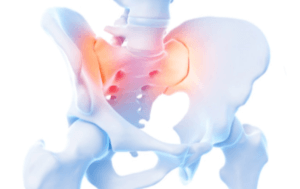With many causes of Pelvic Pain, your physiotherapist is highly trained to access and treat the wide variety of causes.
Pelvic Pain
There are several causes and types of pain around the pelvis. One of the most common is Sacroiliac Joint Pain. The sacroiliac joints (SIJ) are two small joints that connect your lower spine to the pelvis.
The SIJ are weight-bearing joints which allow for absorption of impact of the upper body and legs to the spine during normal movement. These joints have many ligaments and muscles, creating a very rigid stable joint that, by design, does not move freely like many of our other joints. We need this stability to absorb forces and impact.
What causes SIJ pain?
SIJ pain is commonly caused by a change in loading or forces the joint can tolerate. In some people, because of either trauma, stiffness, muscle weakness or often pregnancy, it exposes the SIJ to increased forces through the joint that may cause pain and dysfunction.
Hormones released during pregnancy can increase ligamentous laxity. This is to allow the pelvis to move during labour and allow the baby’s passage through the birth canal. Unfortunately, this increase in ligamentous laxity, whilst essential for natural delivery of a baby, can cause increased movement of the sacroiliac joint and subsequently pain.
What are the symptoms of SIJ pain?
Common symptoms of SIJ Pain Include:
- Pain with sitting and/or standing

- Pain with walking / Running
- Pain moving from sitting to standing
- Pain standing on one leg
- Pain rolling in bed or getting out of the car
- Pain walking up / down stairs
SIJ pain is often felt as low back pain and/or as pain localised on one side or both sides of the buttocks. Sometimes, pain may radiate from the buttocks down the back of the thigh.
Physiotherapy is a first line treatment for managing SIJ pain. Physiotherapists will work with you to identify a pattern of aggravating activities, loads and postures, and help you change these to improve your symptoms. Soft tissue work can also be helpful to release associated muscle tension. Physiotherapists will work to identifying potential muscle weaknesses around the back, hips or legs. They will then develop a management plan to increase load and strengthen these muscles. Often bracing or taping can significantly reduce pain felt in the SIJ. This can be a treatment in the initial management of SIJ injuries.
Our highly trained physiotherapists can assess and treat SIJ pain and other causes of pelvic pain. Please get in touch with us if you have been suffering from pain or think you may have an injury requiring assessment.
